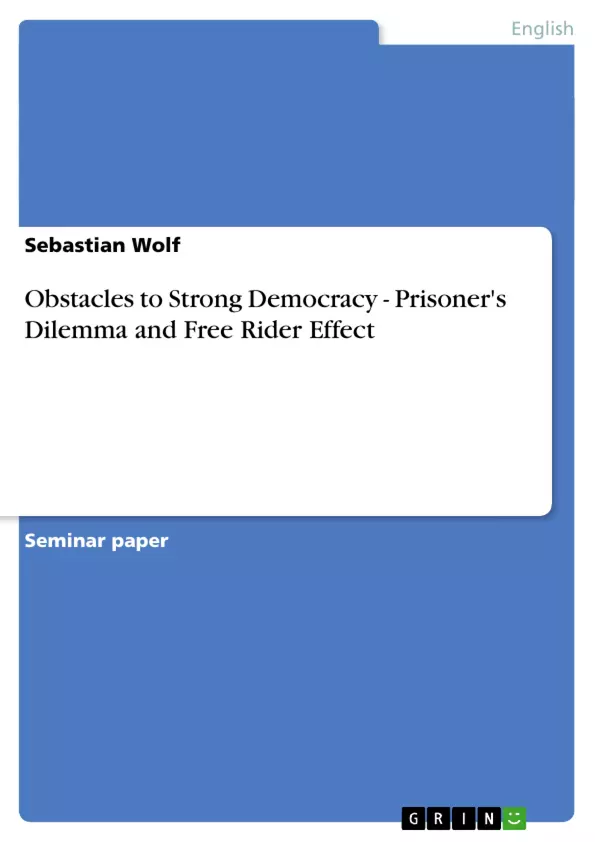In order to establish a strong democracy, Barber thinks, an institutional framework has to be created. The institutions have the purpose to give people the opportunity to become engaged citizens, an opportunity that is not yet provided for, that is not provided for in a liberal democracy. Barber says, that “strong democracy must offer a systematic program of institutional reforms rather than a piecemeal package of particularistic, unrelated modifications” (p. 263). Therefore the twelve points of his strong democratic program have to be seen as one unitary complex. “The potency of the reforms offered here”, Barber continues “lies almost entirely in their capacity for mutual reenforcement when implemented in concert” (p. 264). Thus, one cannot discuss certain individual points of the agenda without taking the others into account, as well. That is why I will discuss three points that are closely related to each other and not that closely related to the others 9 points. Nevertheless it will be necessary to take a look at the left out points at the end of the discussion to see if they entail provisions that re-enforce or support the ones our focus is laid on. My strategy is the following: In the fist part of the essay I will describe the three points of the agenda I want to discuss. The institutions I want to discuss are the Neighborhood Assemblies, the Civic Communications Cooperative and t a Civic Videotext Service. In the second part I will discuss and criticize them, focusing on the question of the practical possibility of their realization. Therefore I will at first lay down a theoretical foundation that is alternative to Barbers. I will explain the prisoner’s dilemma and the free rider effect. And I will show which obstacles they place on the strong democratic program and how the strong democratic program deals with these problems. I will then show that, given this new focus, the three points of the Strong Democratic agenda are not likely to succeed. They are not likely to succeed even if the other points of the program are taken into account.
Inhaltsverzeichnis (Table of Contents)
- Introduction
- Description of the Neighborhood Assemblies
- Description of the Civic Communications Cooperative
- Description of a Civic Videotext Service
- The Prisoner's Dilemma
- The Free-Rider Effect
- Practical critique and Conclusion
Zielsetzung und Themenschwerpunkte (Objectives and Key Themes)
This paper analyzes the challenges of establishing a strong democracy as defined by Benjamin Barber, focusing on the practical feasibility of his proposed institutional reforms. The paper explores the practical limitations of the proposed "Strong Democratic program" within the context of the "Prisoner's Dilemma" and "Free-Rider Effect." The author argues that these concepts, which highlight the inherent difficulties of collective action and individual rationality, pose significant obstacles to the realization of Barber's vision.
- The challenges of establishing a strong democracy as defined by Benjamin Barber
- The practical feasibility of Barber's proposed institutional reforms
- The "Prisoner's Dilemma" and "Free-Rider Effect" as obstacles to collective action
- The potential impact of these concepts on the "Strong Democratic program"
- The limitations of the proposed institutions in overcoming these challenges
Zusammenfassung der Kapitel (Chapter Summaries)
- Introduction: This chapter introduces the concept of strong democracy as envisioned by Benjamin Barber, highlighting the need for institutional reforms to create an environment for engaged citizens. The author outlines the structure of the paper, focusing on three specific points of Barber's program: Neighborhood Assemblies, Civic Communications Cooperative, and Civic Videotext Service.
- Description of the Neighborhood Assemblies: This chapter provides a detailed description of Barber's proposal for Neighborhood Assemblies. These assemblies are envisioned as forums for public discussion and deliberation, aiming to foster civic engagement and local accountability. The chapter explores the potential benefits of these assemblies as civic educational institutions and their role in empowering citizens.
- Description of the Civic Communications Cooperative: This chapter introduces the concept of the Civic Communications Cooperative (CCC), an organization designed to regulate and promote civic and democratic uses of telecommunications. The CCC aims to address the potential dangers of parochialism associated with Neighborhood Assemblies by facilitating wider communication and collaboration.
Schlüsselwörter (Keywords)
The main keywords and focus topics of this work include strong democracy, institutional reforms, civic engagement, Prisoner's Dilemma, Free-Rider Effect, Neighborhood Assemblies, Civic Communications Cooperative, civic telecommunication, and collective action.
- Quote paper
- Sebastian Wolf (Author), 2004, Obstacles to Strong Democracy - Prisoner's Dilemma and Free Rider Effect, Munich, GRIN Verlag, https://www.grin.com/document/40512



